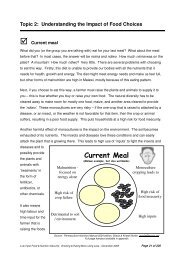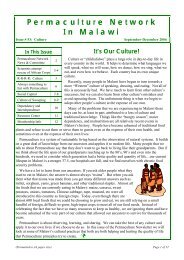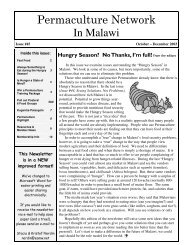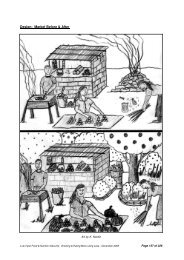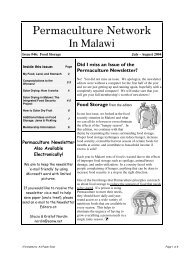Permaculture, Final Capstone Paper 5-26, Hope - Never Ending Food
Permaculture, Final Capstone Paper 5-26, Hope - Never Ending Food
Permaculture, Final Capstone Paper 5-26, Hope - Never Ending Food
Create successful ePaper yourself
Turn your PDF publications into a flip-book with our unique Google optimized e-Paper software.
PRESENTATION AND ANALYSIS OF DATA<br />
I. PROFILE OF THE RESPONDENTS<br />
FARMER CHARACTERISTICS<br />
Specific farmer characteristics, with the exception of age, have not typically been useful<br />
in explaining farmers’ decisions to adopt certain agricultural practices (Neill & Lee, 2001).<br />
However, several variables were included in the data collection as explanatory variables. Gender<br />
was measured as the dummy variable 8 female, where 1 was entered if participants are female. As<br />
seen in Table 3, fifteen male participants and 12 female participants were selected from four<br />
regions within Malawi. In Nkhata Bay, all 5 participants were male due to an inability to identify<br />
females who fit the specific criteria for participation. The ages of participants ranged from 23 to<br />
75 years, with a mean of 41.<br />
Religion was measured as a dummy variable, where 1 was equal to identification as<br />
Christian. All but one participant identified themselves as Christians with one participant who<br />
identified as Muslim. The variable married was measured as a dummy variable where 1 is equal<br />
to the participant identifying as being married. Three participants are separated or divorced,<br />
while the remaining 24 are married. All participants indicated financial responsibility for<br />
dependents such as children, ageing parents, and ailing family members and 20 of 27 participants<br />
indicated guardianship for at least one orphan child. This variable, dependents, was measured as<br />
a continuous variable indicating the number of dependents in the household. Excluding<br />
participant 17, who reported responsibility of <strong>26</strong> orphans, the mean of dependents among<br />
participants is 6.<br />
8 Dummy variable refers to the method of quantifying data that does not have quantitative value. Ex. 0 is equal to<br />
male, while 1 is equal to female.<br />
27



